I’ve been an iOS user for 5 years now which is natural as I also use Macs. I love the devices and software but in doing the podcast and seeing so much momentum with Android I had an itch – I really wanted an Android device to play with. I didn’t want a phone as that would involve a contract and I didn’t want a device that had a companies UI grafted on top of vanilla Android. So when the Nexus 7 was launched it seemed to be the ideal device for me to get. The price drop/increased spec’s at the start of November made the choice even easier so I picked up a 32GB Nexus 7 in the middle of November.
As I already have a iPad and iPhone 5 (both new this year) it’s definitely a luxury purchase as it wasn’t as if I had a gap in my gadget library but it has allowed me to compare the different form factors and understand their strengths and weaknesses. What I was most interested in was the software – how good is Android now that Jelly Bean (Android 4.2) is launched and how strong is the third party support? I hate the iOS vs Android posts on the web as the two camps are so entrenched it’s hard to get a view that’s accurate. At least buying the Nexus means I can form my own view and I can also be more informed about Android. I’m also a geek so it was a brand new device and ecosystem to enjoy.
Nexus 7 Hardware
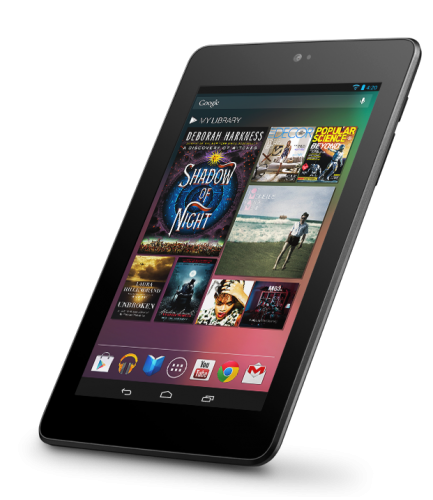
- Ever since Steve Jobs dissed the 7 inch form factor there has been a debate about their value. For me the 7 inch Nexus is an excellent size for a tablet. I can hold it in one hand and read from it easily. I’ve not had an issue with touch points or that my hands are too big for the screen. Indeed Apple bringing out the iPad Mini shows that Jobs ire was more to do with competition to the iPad rather than a 7 inch tablet is too small.
- The screen quality is excellent. Much is made of retina screens but I find the text quality on the Nexus 7 is great. No eye strain and no visible pixels either. The screen is 216 ppi which is less than the 264 ppi that the iPad has but similar to the Macbook Pro which has a ppi of 220. One point to note is the screen felt washed out at first. I found that having the brightness set to automatic set it far too low and my current setting is around 40-50% which is ample for me. Video playback is excellent too – it’s a great device for watching video’s on but more of that later.
- The weight is excellent. I think this is the biggest advantage over an iPad. I can hold it in one hand, I can read easily on planes, at work or around the house without getting arm fatigue and unlike the iPad the weight is just not an issue. It also feels good in the hand with a grippy dimpled plastic back which makes it less likely that you’ll drop the Nexus.
- Overall build quality is good but not quite to the same standard as Apple but it is a lot cheaper that the iOS devices. It never feels cheap though – considering it’s only £160 for the 16GB version it’s a steal at that price.
- Landscape mode isn’t the best. It feels squashed and I find it difficult to work in that orientation unless it’s for watching a film. Limitations of a 7 inch tablet with this form factor.
- The 7 inch tablet is great for reading, watching video, Twitter et all but I do have issues with it as a work device or content creator. The iPad can do all those things but I found the screen just to small in landscape to create anything useful. Another issue is the lack of software written specifically for Android tablets. More on that later.
Android
The Nexus 7 came with Jelly bean – Android 4.1 and after a couple of days was updated to Android 4.2 which Google called a new flavour of Jelly Bean. For me Android has really matured over the last 18 months with Google now focussing on performance and usability. Previous versions had played tennis with iOS over features but every time I used an Android device they felt clunky and awkward to use. Performance was OK but was never as good as an iOS device.
Jelly Bean has addressed performance via what Google called Project Butter. This basically meant the engineers at Google have implemented a variety of new techniques at a low level within Android to address performance issues that were previously seen. On the whole I’ve found Android on the Nexus 7 to be a good performer. Generally app’s launch quickly, swiping around the various screens and app’s is fast and on the whole I’ve been impressed. I do notice pausing and slowdown from time to time. I can partly put that down to app’s running in the background, widgets refreshing etc as there is far more potentially running on an Android device compared to iOS but there are times when I get stuttery performance and there seems to be nothing running that could be causing it. I’ve also had the Nexus crash more than a handful of times during operation requiring a reboot of the tablet. Nothing disastrous but certainly a poor experience compared to iOS. Google have more work to match iOS performance based on what I’ve seen over the last month. I also followed a tip that I found online to disable background synchronisation of Google Currents and this has reduced the stuttering I was seeing but not eliminated it completely.
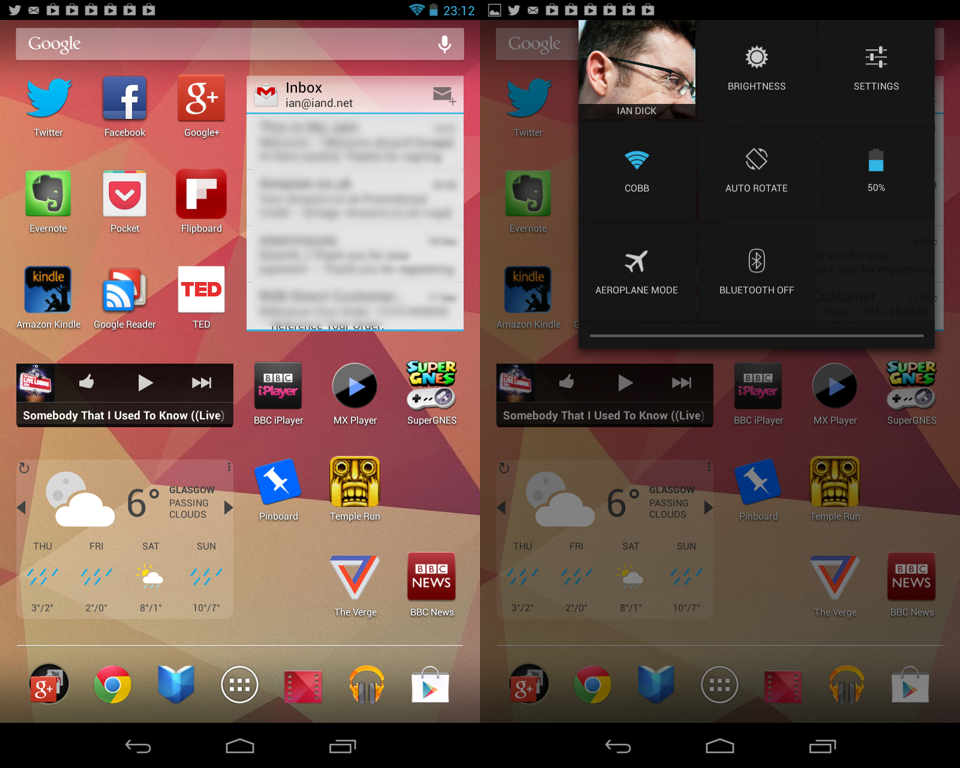
Android allows for far more customisation than iOS. It’s a tinkerers dream. Live wallpapers, widgets, lock screen widgets…the list goes on. There’s a massive amount of content on the Google Play store just to cater for this market, some great and some junk. I did have a couple of live wallpapers switched on but found them distracting. Widgets too I find hit and miss although I love Eye in Sky which is a clean weather widget and detailed weather app. Thats one area I love about Android – if I want to do something on the home screen I can probably do it either by default or by adding an app.
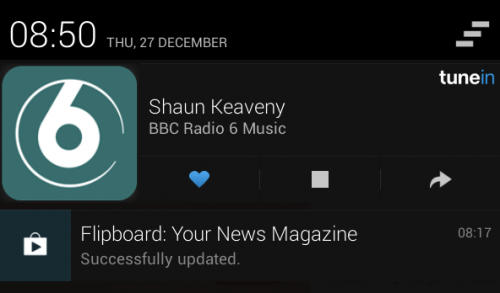
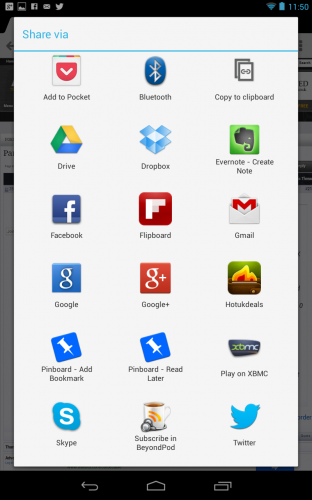
Android has seen some innovation with regards keyboard input. Swype has been around for a while which I’ve never tried but 4.2 saw Google introduce it’s own gesture typing. It actually works pretty well but I’m faster with the normal keyboard. Another form of input is voice and this works much better than Apple’s voice dictation. It’s pretty reliable with my accent like Apple’s is but I found it to be faster on Android and Google seems to analyse the context of the text and correct mistakes as you speak, overall making it more accurate. The other advantage over iOS is speed – it shows you the converted speech as you speak unlike iOS which sends everything away to the server for conversion only when you stop.
One thing that Android now supports that many have asked for years on iOS is multiple users. I’ve not tried it and to be honest I don’t see it as necessary. A tablet or phone is such a personal device that you would ideally want one device per user. Obviously I have no kids as anyone with a family is probably screaming right now saying I’m an idiot but each child in your family probably wants their own device or to use the device at the same time as each other. User accounts won’t help with that.
I was impressed with Google’s web and sync services. Signing in with my main Google account saw bookmarks and e-mail available easily. Content from the book and music store was also available. In November Google launched their own music matching service similar to iTunes Match with one main difference – it was free. Having all my music available on the Nexus has been great and I like the Android music player. It’s also nice to be free of syncing with a desktop client like iTunes. Something I thought was a bit strange is that 4.2 came with two e-mail clients. Email and Gmail. Why both which just confuses a new user.
One final plus point of Android has been Google Now. This has been much talked about as Google’s attempt at Siri and I can see why. Google Now is activated via Google Search. Depending on how you’ve configured Google Now searching by text or voice will initiate a search as normal but the answers can now potentially come via the Now interface. Ask “do I need an umbrella” and you will get a card with the weather and audio confirmation that you do need an umbrella as it’s raining in Glasgow. That result will be relevant to your current location too although I’m sure that for Glasgow it’s just a “yes, it’s raining”. Ask who the author of Harry Potter is and you will get a card showing JK Rowling and also be told it’s JK Rowling. When Google Now can’t display an answer or doesn’t know an answer the normal Google Search results are displayed.
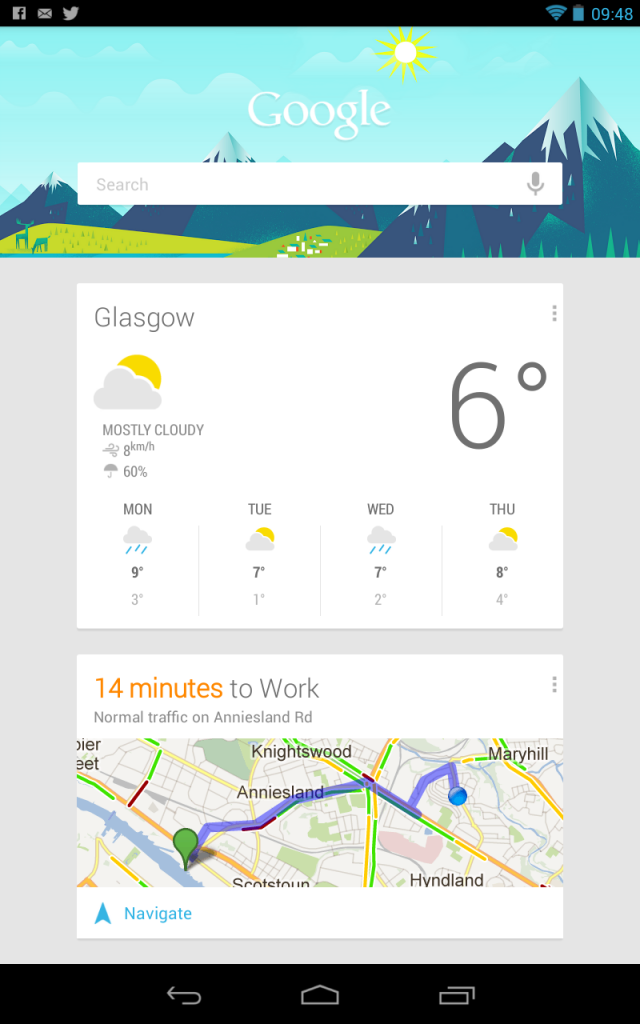
The second aspect of Google Now is that if the conditions are right Google Now will then show you anything from current weather to share prices, traffic conditions to boarding tickets and show the results via a card underneath the search query. It’s second guessing what you need right now and displaying the content without asking. This is very impressive and it’s quite scary how it surfaces the right content at the right time. Google Now uses your e-mail, calendar, search history, current location and a number of other data sets to function correctly so you do have to allow it access to everything but the results so far have made it worthwhile for me.
Whats clever is you don’t see Google Now as a separate app or tool – it’s built into Google Search and with rumours of Now coming to Chrome it will be interesting to see how Google Now grows over the various platforms. Will we see it added to iOS as voice has been in the last few months? Imagine using Glass and Google Now displays information as you need it?
Overall I’ve been impressed with Android 4.2 It looks good, has great functionality and performance is good enough. It still doesn’t have the overall polish of iOS and for me seems to be more unstable than iOS but it has matured to a level that guarantees a great user experience. I do wonder what Android does next? Like iOS are we now in a world of incremental (and small) updates?
Apps
It’s ok having a great operating system and good hardware but it’s pointless if there is no third party support. One of the strengths of iOS is the App Store especially on the iPad where app’s constantly show that it’s not just a consumption device. What I’ve found so far is that it’s hit and miss on Android for tablets. I’m sure for smartphones there’s everything you could want but I’ve struggled to find some app’s that I love on iOS and they (or equivalents) just don’t exist on Android. Despite my moaning I can see in just a month it’s an improving story.
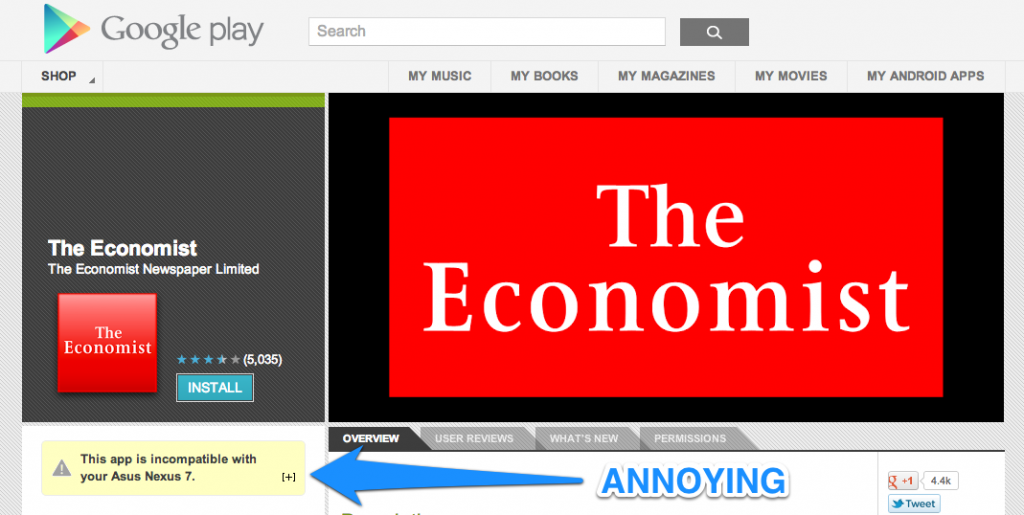
One example is iPlayer. When I picked up the Nexus one of the first apps I wanted to install was iPlayer. But I couldn’t. Like The Economist app above I got the error “This app is incompatible with your Asus Nexus 7”. Nice. I couldn’t believe that the BBC didn’t support the number one Android tablet. Roll on a month and the BBC announce and launch iPlayer support for Android 4.2. iPlayer now works great on the Nexus although it isn’t feature complete with iOS which the BBC have committed to in 2013. One of the problems with Android is fragmentation which the BBC talk about frequently. Another app that works great on Android is Flipboard. This was first launched on iOS and after a year or so appeared on Android. But I was disappointed with the version on the Nexus. It worked like a phone app and didn’t take advantage of the tablet. Thankfully an update came out a couple of weeks ago that saw Flipboard optimised for tablets and it now works a lot better.
Applications optimised for tablets are still an issue on Android but it is an improving picture as the market share for the Nexus 7 and Kindle Fire grows. I’d expect 2013 to only improve and for the gap between the application libraries to improve. I’ve also struggled to find app’s that are Android exclusives and not available (or a good equivalent) on iOS apart from apps like Tasker which allow you to create actions based on contexts – turn off audio at night, switch profile at work, change settings depending on the app you’ve launched. It’s amazing how much can be customised from just this one app – a real advantage of Android. The other app’s I see lots of are anti-virus tools, file managers, widgets and wallpapers so when you see articles comparing app store sizes remember that each store features a lot of crud but there’s categories on Android that just don’t exist in iOS.
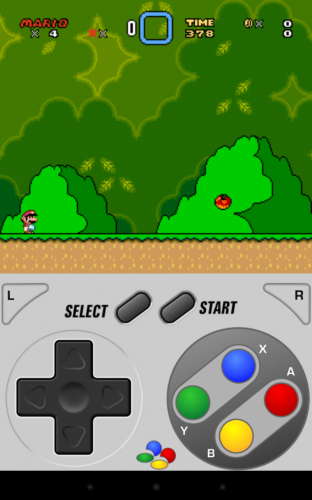
One final aspect I want to highlight is that the Google Play store isn’t the only source of app’s on Android. Goto Settings, Security and check Unknown Sources and you can install app’s obtained from outside the Google Play store – just make sure that you enable Verify Apps too. While this then allows you to download cracked Android titles and puts you at risk of installing malware and viruses, it also opens up another source of apps – Amazon. You can install the Amazon app store which brings the advantage of daily free app’s. Quality is hit and miss but there have been some great app’s made available for free like TuneIn Radio Pro and OfficeSuite Pro. In fact Amazon have made 15 of their better apps available again for free until 31st December so if you act quickly you can get some great free titles.
Conclusions
So after a month of using the Nexus 7 what do I think of the tablet and Android as a platform:
- The Nexus 7 is a great tablet. Fast, light and a good quality screen.
- Android is pretty fantastic. Can do virtually anything on the platform but it doesn’t feel as polished or smooth to use as iOS. Flexibility (Android) vs Performance (iOS).
- Lot’s of app’s available but there is a noticeable lack of tablet app’s. Increased market share for Android devices and time will surely address.
- I use the Nexus for consumption of media (especially reading) but the iPad to actually do things. Combinations of form factor (bigger screen better) and apps.
It will be interesting to see what Google does next with it’s hardware. Reduce prices more on current hardware while introducing higher spec new versions? Either way it’s clear that Apple no longer owns the tablet market and that iOS needs to start taking bolder steps forward or customers will start to look elsewhere as there are some great alternatives out there.
Ian, this was a great and fair review, well done. Clearly for most people the decision about which platform is best comes down to where they have invested their money. Thinking about it, if either of the big players really wanted to encourage switching hardware platforms, then they should offer some kind of multi platform license for applications, or perhaps just a transferrable license. So if someone buys an application they can use it on the other device without having to buy it again.
It’s something I could see Google doing…but Apple would never do it. In fact it’s something I could have seen Google doing a couple of years ago when they introduced the Nexus and for the app’s you currently own we will provide an Android licence. With the way the market share is now they probably don’t see it as an issue now.